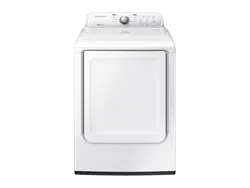Documents: Go to download!
- Owner's manual - (English, French, Spanish)
- Installing your dryer
- Operating instructions, tips
- Care and cleaning
- Special laundry tips
- Troubleshooting
Table of contents
User manual Electric Dryer for Samsung DV40J3000EW/A2
Installing your dryer
Ducting requirements
- Use a 4-inch (10.2 cm) diameter rigid aluminum or rigid galvanized steel duct.
- Do not use a smaller duct.
- Ducts larger than 4 inches (10.2 cm) in diameter can cause increased lint accumulation. Lint accumulation should be cleaned regularly.
- If a flexible metal duct must be used, use the type with a stiff sheet metal wall. Do not use a flexible duct with a thin foil wall. Serious blockage can result if the flexible metal duct is bent too sharply.
- Never install any type of flexible duct in walls, ceilings, or other concealed spaces.
- Keep the exhaust duct as straight and short as possible.
- Secure joints with duct tape. Do not use screws.
- Plastic flexible duct can kink, sag, be punctured, reduce airflow, extend drying times, and affect dryer operation.
- Exhaust systems longer than recommended can extend drying times, affect machine operation, and may collect lint.
- The exhaust duct should end with an exhaust hood with a swing-out damper to prevent back drafts and the entry of wildlife. Never use an exhaust hood with a magnetic damper.
- The hood should have at least 12 inches (30.5 cm) of clearance between the bottom of the hood and the ground or other obstruction. The hood opening should point down.
- Never install a screen over the exhaust outlet.
- To avoid lint buildup, do not exhaust the dryer directly into a window well. Do not exhaust under a house or porch.
- If exhaust ductwork must run through an unheated area, the duct should be insulated and slope slightly down towards the exhaust hood to reduce condensation and lint buildup.
- Inspect and clean the interior of the exhaust system at least once a year. Unplug the power cord before cleaning.
- Check frequently to be sure the exhaust hood damper opens and closes freely.
- Check once per month, and clean at least one time per year. Note: If clothes are not getting dry, then check ducting for obstructions.
- Do not exhaust dryer into any wall, ceiling, crawl space, or concealed space of a building, gas vent, or any other common duct or chimney. This could create a fire hazard from lint expelled by the dryer.
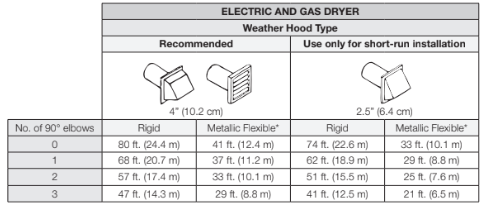
- Do not use non-metallic flexible duct.
Location considerations
- Locate the dryer where there is enough space at the front for loading the dryer, and enough space behind for the exhaust system. This dryer is factory-ready for rear exhaust. To exhaust out the bottom or the right or the left (electric model only), use the accessory exhaust kit (sold separately). Instructions are included with the kit. It’s important to make sure the room has enough fresh air. The dryer must be located where there is no air-flow obstruction.
- On gas dryers, adequate clearance as noted on the data plate must be maintained to ensure adequate air for combustion and proper dryer operation.
- Do not install or store the dryer in an area where it will be exposed to water and/or weather. Keep the dryer area clear of combustible materials, casoline, and other flammable vapors and liquids. A dryer produces combustible lint. The area around the dryer should be kept lint free.
Alcove or closet installation
- No other fuel-burning appliance should be installed in the same closet as the dryer.
- WARNING: To reduce the risk of fire, you must exhaust the dryer to the outdoors. See Exhaust information section.
- Minimum clearances between the dryer and adjacent walls or other surfaces are: 2” in front, 17” on top, 1” on either side, and 5” in the back.
- The closet front must have two unobstructed air openings for a combined minimum total area of 72 in2 with 3” minimum clearance on the top and bottom. A louvered door with equivalent space clearance is acceptable.
Installation - General procedure
To install the dryer, follow these steps:
- Move your dryer to an appropriate location for installation. Consider installing the dryer and washer side- by-side so you have easy access to both appliances.
- If you need to change the direction of the door, go to Door Reversal on page 19. When done, return to Step 3 below.
- Review the Exhausting section before installing the exhaust system. Install the duct work from your dryer to the exhaust hood. The crimped end of the duct sections must point away from your dryer. DO NOT use sheet metal screws when assembling ducting. These joints should be taped. Never use plastic flexible exhaust material.
- If you have an electric model, skip to Step 6. If you have a gas model, go to the next step.
- Review the Gas Requirements section, then follow the lettered steps below.
a. Remove the pipe thread protective cap.
b. Apply pipe joint compound or about 1 1/2 wraps of Teflon tape over all threaded connections.
c. Connect the gas supply to your dryer. An additional fitting is required to connect the 3/4” (1.9 cm) female thread end of a flexible connector to the 3/8” (1 cm) male threaded end on the dryer.
d. Securely tighten the gas line fitting over the threads.
e. Turn on the gas supply. Check all gas connections for leaks using a soap solution. If bubbles appear, tighten the connections and recheck. DO NOT use an open flame to check for gas leaks.
f. Go to Step 6 on the next page
6. Review the Electrical Requirements section, then follow the 3 Wire system connection instructions (Step 7) or 4 Wire system instructions (Step 8) below.
7. Three Wire system instructions:
A. External ground connector
B. Neutral grounding wire (white)
C. Center silver-colored terminal block screw
D. Neutral wire (white or center wire)
E. 3⁄4” (1.9 cm) UL-listed strain relief
1. Loosen or remove the center terminal block screw.
2. Connect the neutral wire (white or center wire) of the power cord to the center, silver-colored terminal screw of the terminal block. Tighten screw.
See other models: DV42H5000EW/A3 DV42H5000GW/A3 DV22K6800EW/A1 DV50K7500EV/A DV50K7500EW/A3
3. Connect the other wires to outer terminal block screws. Tighten screws.
4. Tighten the strain relief screws.
5. Insert the tab of the terminal block cover into your Dryer’s rear panel slot. Secure the cover with a hold-down screw.

8. Four Wire System instructions:
A. External ground connector
B. Green or bare copper wire of power cord
C. 3⁄4” (1.9 cm) UL-listed strain relief
D. Center silver-colored terminal block screw
E. Neutral Grounding wire (white)
F. Neutral wire (white or center wire)
1. Remove the External ground connector screw.
2. Connect the ground wire (green or unwrapped) of the power cord to the external ground connector screw. If you want to connect B (Green or bare copper wire of power cord) to the Neutral Post without connecting it to A (cabinet ground), call a service technician.
3. Loosen or remove the center terminal block screw.
4. Connect the neutral wire (white or center wire) of the power cord and the appliance ground wire (white or green/yellow stripes) under the central screw of the terminal block.
5. Connect the other wires to the outer terminal block screws. Tighten screws.
6. Tighten the strain relief screws.
7. Insert the tab of the terminal block cover into your Dryer’s rear panel slot. Secure the cover with a hold-down screw.
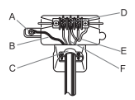
9. To ensure that the dryer provides optimal drying performance, it must
be level. To level the dryer, follow the lettered steps below:
a. Using a level, check if the dryer is level side to side and then front to back.
b. If the dryer is not level, adjust the leveling feet on the bottom of the dryer until the dryer is level side to side and back to front. Turning the feet clockwise retracts the feet. Turning the feet clockwise loosens and extends them.
10. Make sure all gas connections (on gas models) and exhaust, and electrical connections are complete. Plug in your dryer, and then check its operation by using the checklist on the next page.
11. For GAS MODELS ONLY. The burner may not ignite initially due to air in the gas line. Allowing your dryer to operate on a heat setting will purge the line. If the gas does not ignite within 5 minutes, turn your dryer off and wait 5 minutes. Be sure the gas supply to your dryer has been turned on. To confirm gas ignition, check the exhaust for heat.
Final installation check list
- The dryer is plugged into an electrical outlet and grounded properly.
- The exhaust ductwork is hooked up and the joints are taped.
- You have used rigid or stiff-walled flexible metal duct material, not plastic flexible duct.
- The dryer is level and is sitting firmly on the floor.
- For gas models: The gas is turned on and there are no gas leaks.
- Start your dryer to confirm that it runs, heats, and shuts off.
Dryer Exhaust Tips
- Make sure your dryer is installed properly so it exhausts air easily.

- Use 4” diameter rigid metal duct. Tape all joints, including at the dryer. Never use lint-trapping screws.

- Keep ducts as straight as possible.

- Clean all old ducts before installing your new dryer. Be sure the vent flap opens and closes freely. Inspect and clean the exhaust system annually.

Don’t let a poor exhaust system slow drying by:
- Restricting your dryer with a poor exhaust system.
- Using a plastic, thin foil, or non-metal flexible duct.
- Using unnecessarily long ducts that have many elbows.
- Using crushed or clogged venting or ducts.
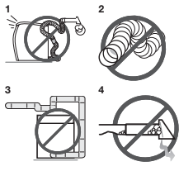
Door Reversal
If you want to reverse the direction of the door, it is recommended calling a qualified service technician.
- Unplug the power cord.
- Remove the four hinge screws from the door
- Remove the door by lifting it
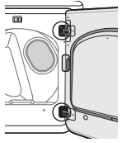
- Remove the two screws from the holder-lever, and then remove the cover-holder.
- Assemble the holder-lever on the opposite side using the screws that were removed from the holder-lever-in Step 4.
- Assemble the cover-holder on the opposite side.

- Remove the two cover-hinges.
- Assemble the two cover-hinges on the opposite side.

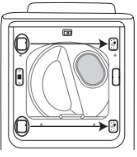
- Remove the 14 screws.
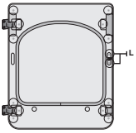
- Remove the holder-glass.
- Exchange the positions of:
: The cover-hinge and handle door
: The holder-hinge and guider- holder glass
- Remove the Lever-Door, and then install it on the opposite side.
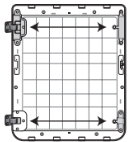

- Remove the cover-hole (P).
- Assemble the holder glass and then fasten the 14 screws that you removed in step 9.
- Attach the cover-hole.
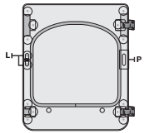
- Install the door on the frame-front and then fasten the 4 screws that you removed in step 2.
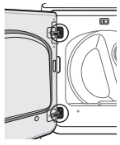

Operating instructions, tips
Overview of the control panel
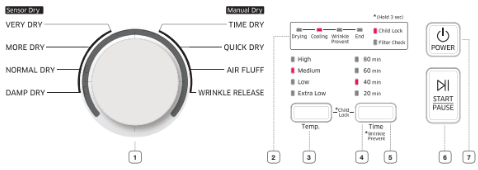
1. Cycle Selector
- To select dryness level in Sensor Dry cycle. Very Dry, More Dry, Normal Dry and Damp Dry are dryness level in Sensor Dry cycle.
- Sensor Dry cycle automatically senses the moisture in the load and shuts the dryer off when the load reaches the dryness level you have selected with Dryness level.
- To select Sensor Dry cycle with Temperature option.
- Corresponding setting of the temperature option, refer to the “cycle chart”
- VERY DRY & MORE DRY – Use this cycle to dry such a large or bulkier fabrics.
- NORMAL DRY – Default setting.
- DAMP DRY – Use this cycle for flat by hanger or ironing.
- TIME DRY – TIME DRY allows you to select the desired cycle time. Turn the Cycle Selector dial to TIME DRY, and then press the Time selection button.
- QUICK DRY – Provides a 40 minute drying cycle.
- AIR FLUFF – The AIR FLUFF cycle tumbles the load at room temperature air.
- WRINKLE RELEASE – The WRINKLE RELEASE cycle will release wrinkles from items that are clean, dry, and only slightly wrinkled, such as clothes from a crowded closet, suitcase or items that have been in the dryer too long after the cycle has ended. WRINKLE RELEASE can be used with any temperature selection.
2. Display
- The Drying light will illuminate and remain lit until the cycle is complete. When your dryer is in the cool-down phase, the Cooling light will illuminate, When your dryer is in the wrinkle prevent phase, the Wrinkle Prevent light will illuminate.
- When the cycle is complete, End light will illuminate in the display panel and until you push the Start/Pause button or the Power button.
- If your dryer is paused during a cycle, the indicator lights will blink until you press the Start/Pause button.
3. Temp Selection Button
- To select the temperature for the load, press the Temp button. An indicator light will illuminate next to the temperature you selected. Press the button repeatedly to scroll through the settings.
- High – For heavy fabrics such as jeans, corduroys, or work clothes with high temperature heat.
- Medium – For cottons, underwear, and linen.
- Low – For wrinkle-free cottons, synthetic fabrics, knits, and permanent press fabrics.
- Extra Low – For heat-sensitive items at a low drying temperature.
4. Time Selection Button
- When using Manual Dry cycles, you can select the drying time by pressing the Time selection button.
- During the Sensory Dry cycle, the time light indicator is off because exact drying times are determined by fluctuating humidity levels.
.5. Select Cycle Option
- Wrinkle Prevent – Wrinkle Prevent provides approximately 180 minutes of intermittent tumbling in unheated air at the end of the cycle to reduce wrinkling. Press the Time (*Wrinkle Prevent) button for 3 seconds.
- The indicator light will illuminate when Wrinkle Prevent is selected.
- The load is dry and you can remove it at any time during the Wrinkle Prevent cycle.
6. Start/Pause selection button
- Press to pause and restart programs.
7. Power button
- Press once to turn your dryer on, Press again to turn it off. If your dryer stays on without touching any buttons or dials over 10 minutes, then the power automatically turns off.
Child lock
Prevents children from playing with your dryer.
Setting/Releasing
If you want to set or release the Child Lock, press the Temp. and Time buttons simultaneously for 3 seconds.
Child Lock Details
- You can turn Child Lock on while your dryer is running.
- Once you turn Child Lock on, no button, except for the Power button, will respond until you turn off the Child Lock function.
- The Child Lock indicator will be lit.
If you have not turned off Child Lock, and then turned the dryer off and on, the Child Lock function will still be on. To turn off Child Lock, follow the instructions above.
When other buttons, except for the Power button, do not respond, check the Child Lock indicator. If Child Lock is on, follow the instructions above to turn Child Lock off.
Clean the lint filter
- After each load.
- To shorten drying time.
- To operate more energy efficiently.
Do not operate your dryer without the lint filter in place.
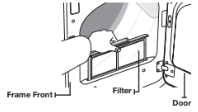
Load the dryer properly
- Place only one washload in your dryer at a time.
- In mixed loads, heavy and lightweight fabrics will dry differently. This may result in lightweight fabrics being dry while heavy fabrics remain damp at the end of a drying cycle.
- Add one or more additional similar items to your dryer when you are drying only one or two items. This improves the tumbling action and drying efficiency.
- Overloading restricts tumbling action, resulting in uneven drying as well as excessive wrinkling of some fabrics.
Getting started
- Load your dryer loosely – DO NOT overload.
- Close the door.
- Select the appropriate cycle and options for the load (Refer to “Cycle chart”).
- Press the Start/Pause button.
- The dryer indicator light will illuminate.
Care and cleaning
Control Panel
- Clean with a soft, damp cloth. Do not use abrasive substances.
- Do not spray cleaners directly on the panel.
- The control panel finish may be damaged by some laundry pre-treatment soil and stain remover products.
- Apply such products away from your dryer and wipe up any spills or overspray immediately.
Tumbler
- Remove any stains from the tumbler caused by crayon, ink, fabric dye (from new items such as towels or jeans) and so on with an all-purpose cleaner.
- Tumble old towels or rags to remove any remaining stain or cleaning substance.
- Once these steps are followed, stains may still be visible, but should not transfer to subsequent loads.
Powder Coated Tumbler
- To clean the powder coated tumbler, use a damp cloth with a mild, non-abrasive cleaner suitable easily marred surfaces.
- Remove cleaner residue and dry with a clean cloth.
Dryer Exterior
- Clean with a soft, damp cloth. Do not use abrasive substances.
- Protect the surface from sharp objects.
- Do not place any heavy or sharp objects or a detergent box on the dryer. They can scratch or damage the top cover of the dryer. Keep these items in the separately purchased pedestal or in a separate storage box.
- The entire dryer has a high-gloss finish. Avoid scratching or damaging the surface when using the dryer.
Dryer Exhaust System
- Inspect and clean the dryer exhaust system yearly to maintain optimum performance.
- The outside exhaust hood should be cleaned more frequently to ensure proper operation.
Special laundry tips
SPECIAL LAUNDRY TIPS
Please follow the care label or manufacturer’s instructions for drying special items. If care label instructions are not available, use the following information as a guide.
Bedspreads & Comforters
- Follow the care label instructions.
- Make sure the item is thoroughly dry before using or storing.
- May require repositioning to ensure even drying.
Blankets
- Use the medium temperature and dry only one blanket at a time for best tumbling action.
- Make sure the item is thoroughly dry before using or storing.
Curtains & Draperies
- Use the low temperature to help minimize wrinkling.
- Dry these in small loads for best results and remove as soon as possible.
Cloth Diapers
- Use the High temperature settings for soft, fluffy diapers.
Down–filled Items (jackets, sleeping bags, comforters, etc.)
- Use the medium temperature setting.
- Adding a couple of dry towels shortens drying time and absorbs moisture.
Foam Rubber (rug backs, stuffed toys, shoulder pads, etc.)
- DO NOT dry on a heat setting. Use the Air Fluff cycle.
- WARNING – Drying a rubber item with heat may damage it or create a fire hazard.
Pillows
- Use the medium temperature.
- Add a couple of dry towels and a pair of clean sneakers to help the tumbling action and to fluff the items.
- DO NOT dry kapok or foam pillows in the dryer. You can dry these items in the dryer only if you use the Air Fluff cycle.
Plastics (shower curtains, outdoor furniture covers, etc.)
- Use the Air Fluff cycle or the Time Dry cycle and the Low or Extra Low temperature settings depending on the care label instructions.
Troubleshooting
Doesn’t run.
- Make sure the door is latched shut.
- Be sure the power cord is plugged into a live electrical outlet.
- Check your home’s circuit breakers or fuses.
- Press the Start/Pause button again if the door is opened during the cycle.
Doesn’t heat.
- Check your home’s circuit breakers or fuses.
- Select a heat setting other than Air Fluff.
- On a gas dryer, check that the gas supply is on.
- Clean the lint filter and exhaust duct.
- Dryer may have moved into the cool-down phase of the cycle.
Doesn’t dry.
- Check all of the above, plus...
- Be sure the exhaust hood outside the home can open and close freely.
- Check the exhaust system for lint buildup. Ducting should be inspected and cleaned annually.
- Use a 4” rigid metal exhaust duct.
- Do not overload. 1 wash load = 1 dryer load.
- Sort heavy items from lightweight items.
- Large, bulky items like blankets or comforters may require repositioning to ensure even drying.
- Check that the washer is draining properly to extract adequate water from the load.
- Load may be too small to tumble properly. Add a few towels.
Is noisy.
- Check the load for objects such as coins, loose buttons, nails, etc. Remove promptly.
- It is normal to hear the dryer gas valve or heating element cycle on and off during the drying cycle.
- Be sure the dryer is leveled properly as outlined in the installation instruction.
- It is normal for the dryer to hum due to the high velocity of air moving through the dryer drum and exhaust system.
Dries unevenly.
- Seams, pockets, and other similarly heavy areas may not be completely dry when the rest of the load has reached the selected dryness level. This is normal. Select the Very Dry setting if desired.
- If one heavy item is dried with a lightweight load, such as one towel with sheets, it is possible that the heavy item will not be completely dry when the rest of the load has reached the selected dryness level. Sort heavy items from lightweight items for best drying results.
Has an odor.
- Household odors from paint, varnish, strong cleaners, etc. may enter the dryer with the surrounding room air. This is normal as the dryer draws the air from the room, heats it, pulls it through the tumbler, and exhausts it outside.
- When these odors linger in the air, ventilate the room completely before using the dryer.
Shuts off before load is dry
- The dryer load is too small. Add more items or a few towels and restart the cycle.
- The dryer load is too large. Remove some items and restart the dryer.
Lint on clothes
- Make sure the lint filter is cleaned before every load. With some loads that produce high amounts of lint, it may be necessary to clean the filter during the cycle.
- Some fabrics are lint producers (for example, a fuzzy white cotton towel) and they should be dried separately from clothes that are lint trappers (for example, a pair of black linen pants).
- Divide larger loads into smaller loads for drying.
- Check pockets thoroughly before washing and drying clothes.
Garments still wrinkled after Wrinkle Release
- Small loads of 1 to 4 items work best.
- Load fewer garments. Load similar-type garments.
Odors remain in clothing after Air Fluff.
- Fabrics containing strong odors should be washed in a normal cycle.
